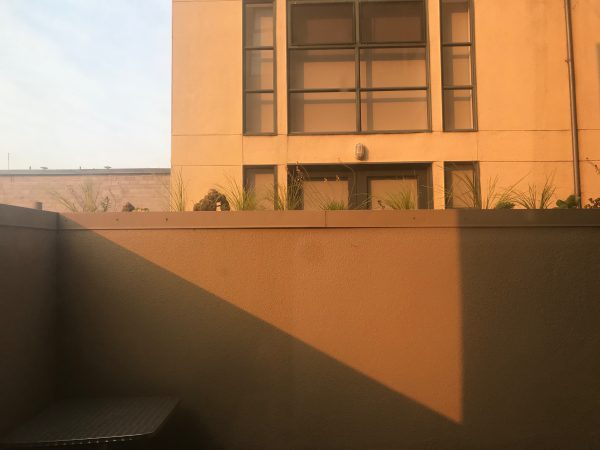
light
Wordless Wednesday: 9596 (Lights)
Wordless Wednesday: Smokey Rose Light
Mary Corse: A Survey in Light, Whitney Museum
We at CatSynth spent the better portion of a recent afternoon at the Whitney Museum of American Art, taking in the entire museum top to bottom. In the first of our reports, we start at the top with a survey of the work of artist Mary Corse.
The exhibition – Corse’s first solo survey at a major institution – focuses on her work in the mid-to-late 1960s as part of the West Coast Light and Space movement. Like many of her contemporaries, Corse was very interested in the use of light as a medium in itself, but her output of light works was almost entirely focused on flat art, i.e., the kind you can hang on walls. This made her a bit of an outlier in the movement.

At first glance, it might be tempting to dismiss her work as “another round of white-on-white paintings from the 1960s.” But what makes it interesting is that light is at the center, rather than texture or pigment; and that she delved into emerging technologies and media to move beyond painting.
The most intriguing pieces in the exhibition were those that used plexiglass and lighting technologies. Corse studied physics and engineering in preparation for this body of work. We see this in her series where custom Plexiglass elements of different depths are juxtaposed next to one another allowing different amounts of light to pass through.

It is a subtle but fascinating set, and I found myself moving back and forth and looking from either side in my own exploration.
Corse also made her own light elements with a variety of technologies, including this piece from 1968 which employed an argon light and frequency generator, once again with her own custom plexiglass. I would have loved to have seen it in
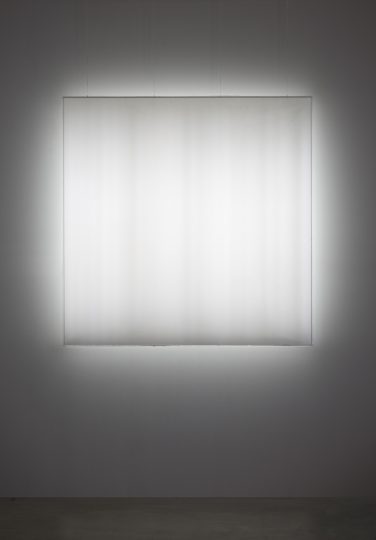
Looking at the bands within the light, I immediately found myself thinking of the amplitudes in a time-varying sound wave, or perhaps a frequency-domain spectrum. It would have been quite interesting to “hear” it.
The final set of work in the exhibition takes an abrupt turn, making the end of this period in Corse’s career. In 1970, she moved from Los Angeles to Topanga Canyon and embarked on her Black Earth Series of paintings.
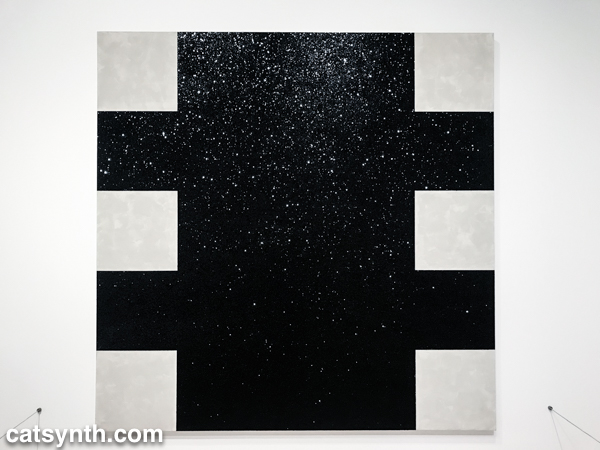
canvas. 108 x 108 in. (274.3 x 274.3 cm). Collection of Sangbeom Kim and Sunjung Kim
Beyond the obvious switch from white to black, there is a break from technology and a return to working with more traditional materials and textures. The “black” in the Black Earth Series are ceramics made in her own kilns. The glossy material is reflective, but also thick and covered in bumps and curves. This is in stark contrast to the plexiglass surfaces of her earlier work and makes a fitting bookend for the survey.
Unfortunately, the exhibition is closing this weekend, but if you happen to be in New York I recommend checking it out. It makes a fine escape from the overwhelm and sensory overload of holiday season.
San Francisco Electronic Music Festival (SFEMF) Night 3
The 19th annual San Francisco Electronic Music Festival concluded yesterday, and we at CatSynth were on hand for the final concert. There were three sets, each showcasing different currents within electronic music, but they all shared a minimalist approach to their musical expression and presentation.
The evening opened with a set by Andy Puls, a composer, performer and designer of audio/visual instruments based out of Richmond, California. We had seen one of his latest inventions, the Melody Oracle, at Outsound’s Touch the Gear (you can see him demonstrating the instrument in our video from the event). For this concert, he brought the Melody Oracle into full force with additional sound and visuals that filled the stage with every changing light and sound.
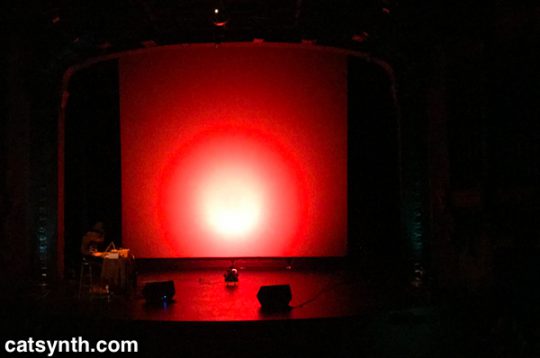
The performance started off very sparse and minimal, with simple tones corresponding to lights. Combining tones resulted in combining lights and the creation of colors from the original RGB sources. As the music grew increasingly complex, the light alternated between the solid colors and moving patterns.

I liked the sound and light truly seemed to go together, separate lines in a single musical phrase, and a glimpse of what music would be if it was done with light rather than sound.
OMMO, the duo of Julie Moon and Adria Otte brought an entirely different sound and presence to the stage.
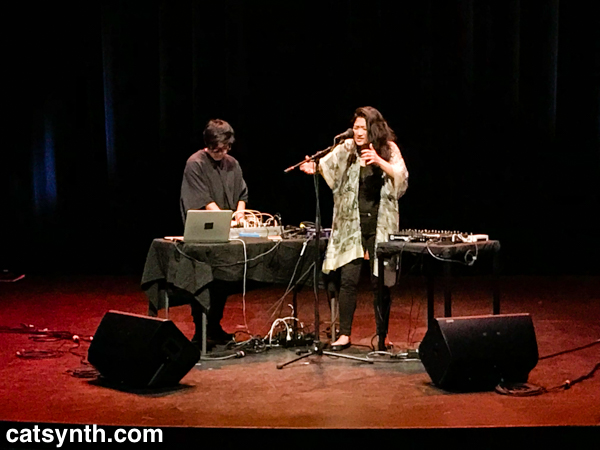
The performance explored the “complexities and histories of the Korean diaspora and their places within it.” And indeed, words and music moved freely back and forth between traditional and abstract sounds and Korean and English words. Moon’s voice was powerful and evocative, and quite versatile in range and she moved through these different ideas. The processing on her voice, including delays and more complex effects, was crisp and sounded like an extension of her presence. Otte performed on laptop and analog electronics, delivering a solid foundation and complex interplay. A truly dynamic and captivating performance.
The final set featured a solo performance Paris-based Kassel Jaeger, who recently became director of the prestigious Groupe de Recherches Musicales (GRM). Sitting behind a table on a darkened stage, with a laptop, guitar and additional electronics, he brought forth an eerie soundscape.
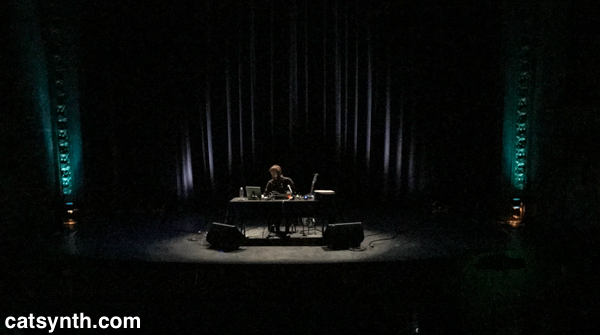
The music featured drone sounds, with bits of recognizable recorded material, as well as chords and sharp accents. The musique concrète influence was abundant but also subtle at times as any source material was often submerged in complex pads and clouds over which Jaeger performed improvisations.
It is sometimes difficult to describe these performances in words, though we at CatSynth try our best to do so. Fortunately, our friends at SFEMF shared some clips of each set in this Instagram post.
Much was also made of the fact that this was the 19th year of the festival. That is quite an achievement! And we look forward to what they bring forth for the 20th next year…
Wordless Wednesday with Luna
Wordless Wednesday: 9931 (City Lights)
Wordless Wednesday: 8775 (San Francisco Light Study)
Wordless Wednesday: Tower in Light
Weekend Cat Blogging and Photo Hunt: Light Stripes
For Weekend Cat Blogging and the Photo Hunt, we preset this photo of Luna with stripes of light.

This was once again taken with the Hipstamatic on the iPhone, using relatively simple lens and film effects that bring out the light.
Weekend Cat Blogging #340 is hosted by Pam at Sidewalk Shoes, with help from Coco.
The Saturday PhotoHunt has a new home. This week’s theme is Lights. Thank you to tnchick for hosting over the past years.
The Carnival of the Cats will be hosted this weekend by Samantha, Clementine and Maverick at Life from a Cat’s Perspective.
And the Friday Ark is at the modulator.


